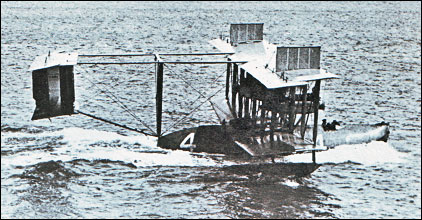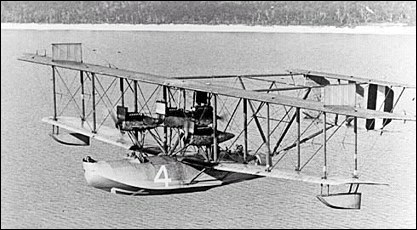|
| During 1917 the US Navy Bureau of Construction and Repair collaborated with Glenn Curtiss in an effort to produce a flying-boat that would be capable of crossing the Atlantic without difficulty. The intention was to ensure that such 'boats would be able to join operations in the war zone immediately after their arrival.
Preliminary designs, drawn up by naval team which included Commander Jerome Hunsaker, were developed by Curtiss and his engineers. The selected configuration was a wide-span biplane with three tractor engines, a short hull to accommodate a crew of five, and a biplane tail supported on booms projecting from the upper wing and the rear of the hull. Detail design was carried out by the Curtiss staff, except for the hull which was the work of US Navy Commander Holden Richardson. Soon afterwards Curtiss received an order for production of the NC 'boat as it had by then been designated (NC for Navy-Curtiss). Four aircraft were to be built by Curtiss, and it was decided that the Naval Aircraft Factory would build six more.
Existing factory space at the Curtiss Garden City, New York factory was greatly expanded with US Navy help for production of the NCs, which were to be taken by road in sections for final assembly at Rockaway Naval Air Station. When World War I ended only the NC-1 had been completed and the original purpose of the design no longer existed. Although the NAF NCs were cancelled, the US Navy decided to go ahead with the four Curtiss 'boats which would be used in a transatlantic flight to the UK. It was felt that the publicity gained by such a flight would be of great value to the US Navy.
Three NC boats (NC-1, NC-3 and NC-4) left Trepassey Bay, Newfoundland on 16 May 1919, NC-2 having already come to grief. Both the NC-1 and the NC-3 came down at sea short of Horta in the Azores, which was to be the first stop. Neither could take off again, the NC-1 being abandoned and its crew taken off by ship, but the NC-3 was able to taxi in to Horta. Only the NC-4 completed the journey to Plymouth successfully, arriving on 31 May following stops at Horta, Ponta Delgada, Lisbon, and Ferrol del Caudillo. The total distance flown from take-off at Rockaway, New York on 8 May was 6317km, completed in 57 hours 16 minutes total flight time.
 | A three-view drawing of NC-4 (800 x 418) |
| MODEL | Curtiss NC-4 |
| ENGINE | 4 x 298kW Liberty 12A inline piston engines |
| WEIGHTS |
| Take-off weight | 12700 kg | 27999 lb |
| Empty weight | 7257 kg | 15999 lb |
| DIMENSIONS |
| Wingspan | 38.40 m | 126 ft 0 in |
| Length | 20.80 m | 68 ft 3 in |
| Height | 7.44 m | 24 ft 5 in |
| Wing area | 226.77 m2 | 2440.93 sq ft |
| PERFORMANCE |
| Max. speed | 137 km/h | 85 mph |
| Ceiling | 760 m | 2500 ft |
| Robby Schwach, e-mail, 16.10.2017 23:36 Looking for relatives of the NC crews that may wish to participate in a 100th anniversary commemorative ceremony in May of 2019. Shasta2088@aol.com or follow on Facebook at 1st transatlantic flight the n.c.4 may 8 to may 27, 1919 reply | | Kathy Hass, e-mail, 16.07.2014 15:23 Randy Lovgren: my grandfather, John Daly Sr., was also a rigger for the Curtiss NC-4! They must've worked very closely together on those wings ;) Looking forward to any information on any 100th Anniversary celebrations of the First Transatlantic Flight of 1919 reply | | David Crocker, e-mail, 30.03.2014 19:48 CROCKER No relation to the above. I wrote a book about the first flight across the Atlantic. The book is based on stories told to me by my father who saw the NC flying boats at Trepassey bay Newfoundland on the occasion of their Atlantic crossing. The book is called Ike's Book of Days available at Amazon in eBook format. reply | | Judith Heuser, e-mail, 24.01.2012 01:04 I too have a NC-4 Medallion and wrote a letter to the Glenn Curtis Museum. This is what he told me about the Medallion "It was commissioned by Glenn Curtis to be given out to the officers and crews of the three NC boats. Also the designers dignataries and guests at a dinner given in honor of the crews at the Commodore Hotel in NYC on July 10, 1919" nothing more was said about the medallion. I do know there is one at the Smithsonian Museum at Dulles Airport ....not on display. reply | |
| | bill daley, e-mail, 22.11.2011 18:13 for a detailed history of the building and flight of the NC-4 and the other NC planes read " FIRST ACROSS' by RICHARD SMITH reply | | bill daley, e-mail, 22.11.2011 18:11 for a detailed history of the building and flight of the NC-4 and the other NC planes read " FIRST ACROSS' by RICHARD SMITH reply | | jerry k, e-mail, 06.10.2011 22:54 The common nickname for the NC planes was "Nancy" for the same reason that the JN-4 was called "Jenny" reply | | J Castronova, e-mail, 18.09.2011 01:11 I recently found one of the 16 Bronze medallions that Glenn Curtiss personally gave each crew member. It is beautiful. Now comes the task of finding out how it ended up in my wife's deceased father's effects.... Does anyone out there have a detailed list of the names of the guys who received one. Maybe there'll be a last name in there that reveals this medal's origin.. Thanks reply | | Randy Lovgren, e-mail, 14.05.2011 20:58 My Grandfather, Charles Havens, worked for Curtiss and was a rigger for the NC-4 and, quite probably, the other NC seaplanes. They spent some time in China with this plane. If anyone has any details about this I would certainly be interested in hearing from you. The NC-4 is now on display at the National Museum of Naval Aviation in Pensacola Florida.
Wikipedia has a great video of the NC-4 Flying and related history reply | | KarenMarie Adams, e-mail, 18.02.2011 22:57 My husband and I have 35mm film footage of the NC-4 regarding this first trans-Atlantic flight. We are trying to find a suitable buyer, preferably one that can afford the restorative and preservative work that is needed. Any information you have about the NC-4, crew, or other remaining film would be greatly appreciated. reply | | Dave Crocker, e-mail, 05.09.2010 22:59 I give lectures on this subject, and here are a few facts: NC-1 was built with just three tractor engines, all WW-I "Liberty" engines. After tests, it was advised that the NC-1 was underpowered, so a fourth engine was added, a pusher just behind the center front tractor engine. The NC-2 was unable to fly due to a fire in the hangar at Rockaway, NY.
There was a crew of 6, the navigator, (Albert C. Read)up in the nose, two pilots, sitting outside, side by side, two engineers, inside, just aft of the 9 fuel tanks, 3 /4 of the way back in the hull, and one radioman in the rear.
After leaving Rockaway, the NC-4 made a forced landing just East of Cape Cod due to two engine failures. Repairs were made at Chatham, Cape Cod, and the NC-4 joined the other planes in Trepassy Bay, and flew on to complete the mission alone. The original Curtiss NC is now at the Pensacola Naval Aviation museum. reply | | James DiLeonardi, e-mail, 07.05.2008 19:12 Number of engines should be 3 tractor & 1 pusher reply | | James DiLeonardi, e-mail, 07.05.2008 19:04 Number of engines should be 3 reply | | Ray Stone, e-mail, 18.04.2008 18:54 My cousin, Elmer Stone, was the pilot for this transatlantic flight. He was Coast Guard pilot #1 and the only Coast Guard member of an, otherwise, all Navy crew.
I have a large poster from the Smithsonian with a picture of the NC4, names of the crew and a 2" square fabric from the original plane. Elmer was awarded a Navy Cross and received a written commendation from then Assistant Secretary of the Navy Franklin D. Roosevelt, dated
23 August 1919 that stated: "I wish to heartily commend you for your work as pilot of the Seaplane NC-4 during the recent trans-Atlantic flight expedition. The energy, efficiency, and courage shown by you contributed to the accomplishment of the first trans-Atlantic flight, which feat has brought honor to the American Navy and the entire American nation..."
On 1 October 1921 he was awarded the Victory Medal with Aviation Clasp and on 23 May 1930 he was awarded a special Congressional Medal, especially designed for the occasion, by the President in the name of Congress for "extraordinary achievement in making the first successful trans-Atlantic flight."
Among other things, I have an original letter on Indianapolis Motor Speedway Corporation letter head from its president, Eddie Rickenbacher, inviting Lt. Cmdr. Elmer Stone to be his guest at the 1934 "Indy 500" race.
The NC-4 made aviation history in May of 1919, but few people today are aware of it. If you ask someone about the first trans-atlantic flight, they invarably mention the Lindberg flight. reply | |
| | Tricia Douma, e-mail, 03.08.2007 03:07 My Grandfather, Albert Stubee, was the Chief Engineer on this aricraft. Are there any drawings or documents that would have his name on them? reply |
|
Do you have any comments?
|
| 
COMPANY
PROFILE
All the World's Rotorcraft
|








